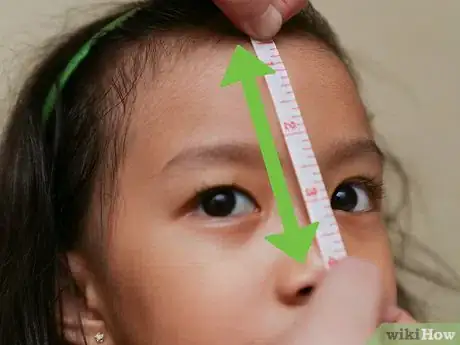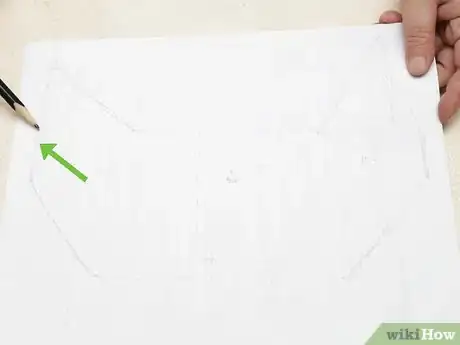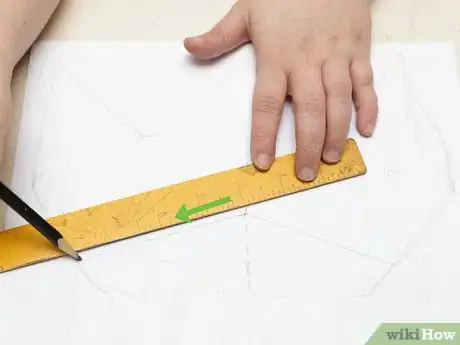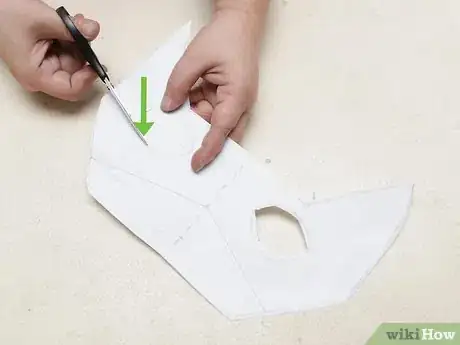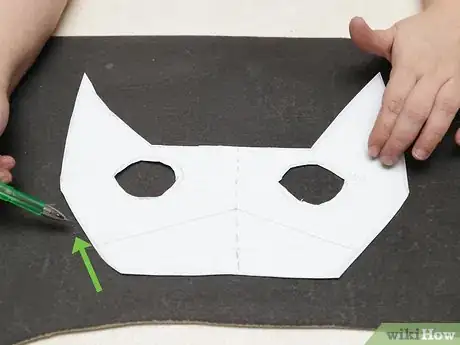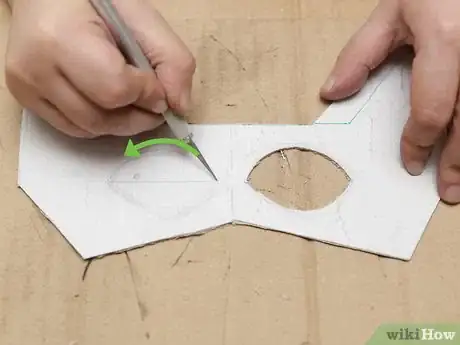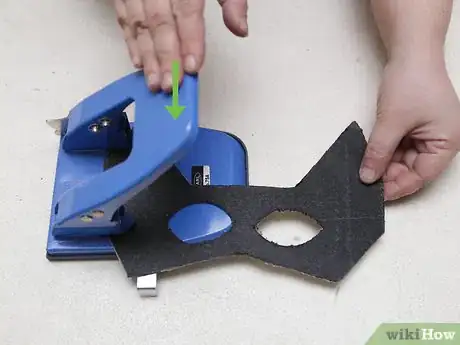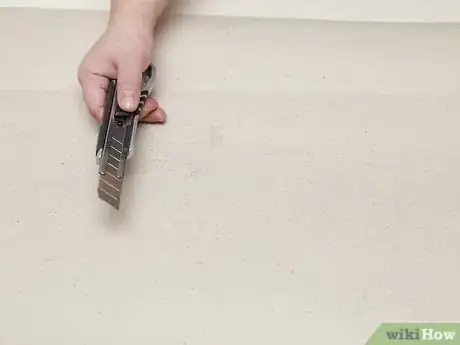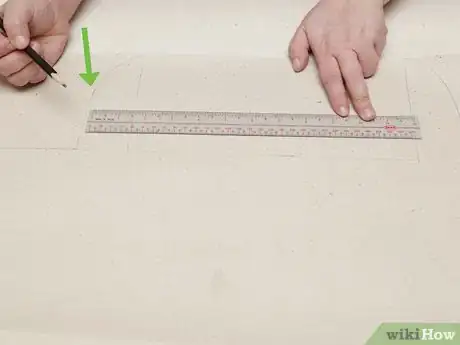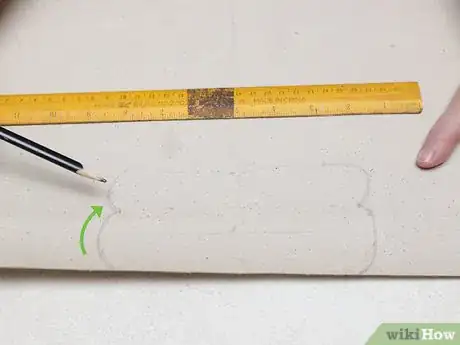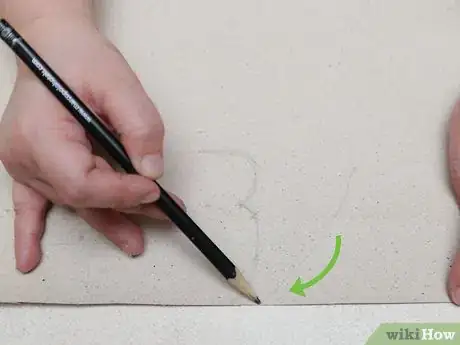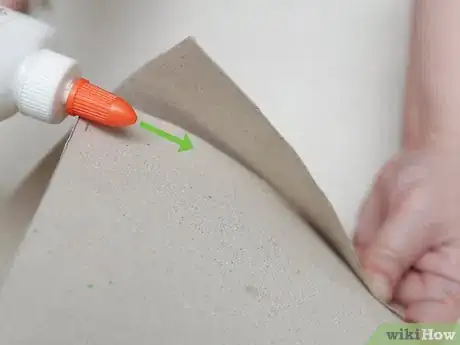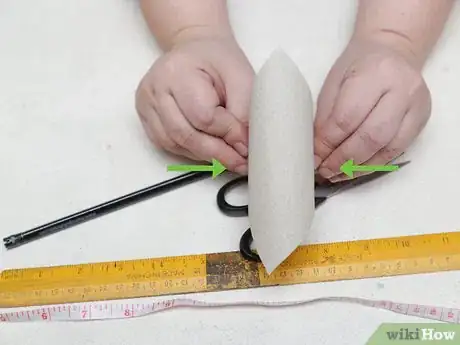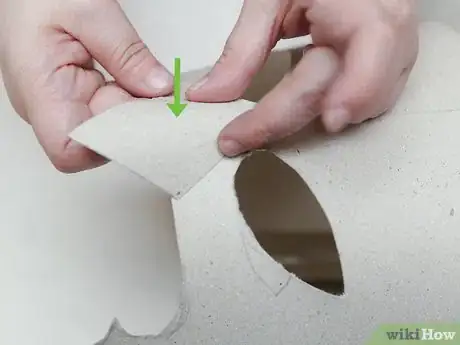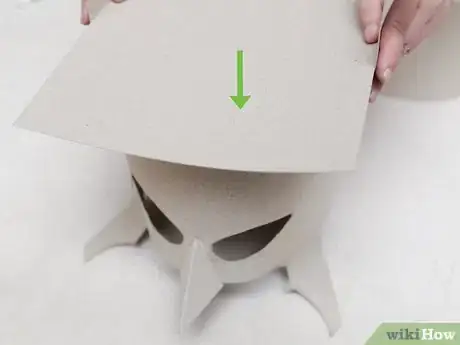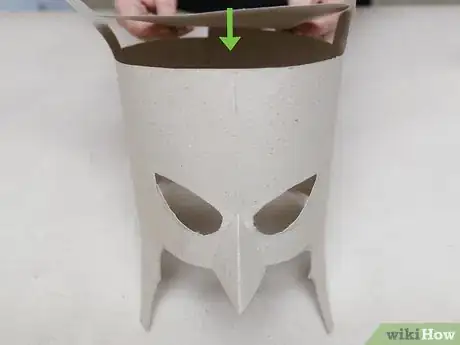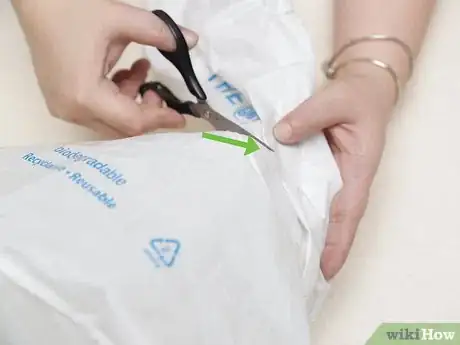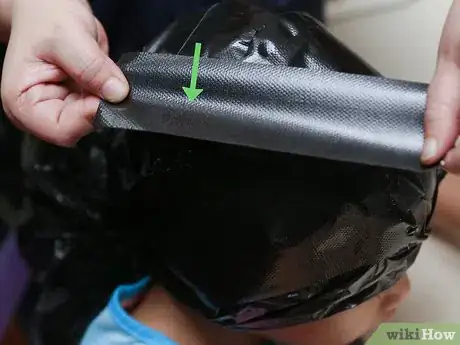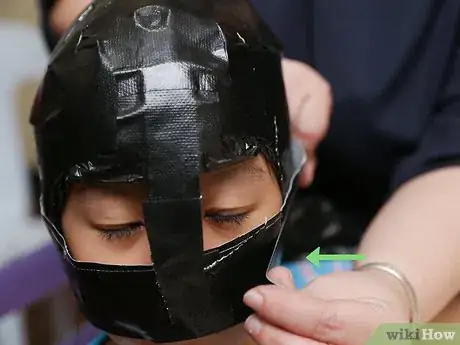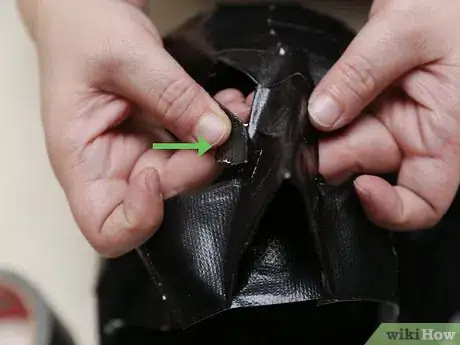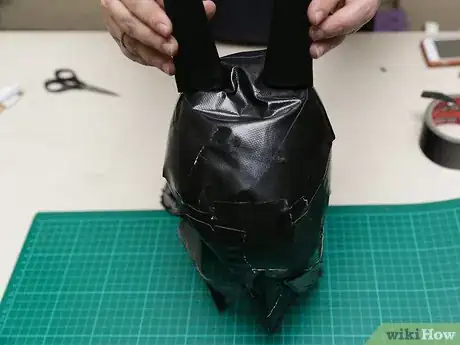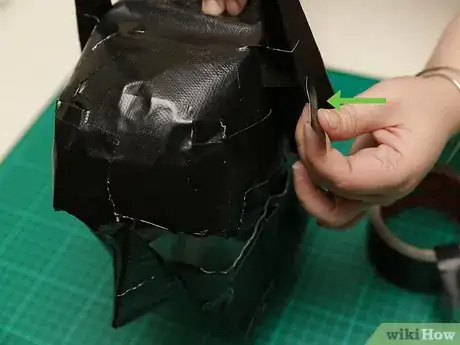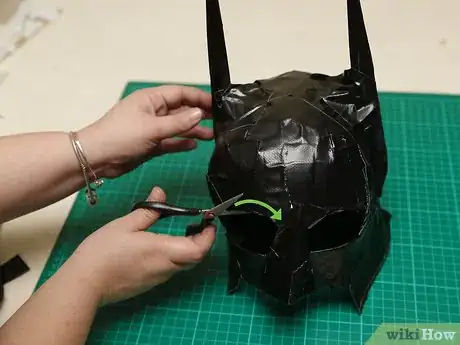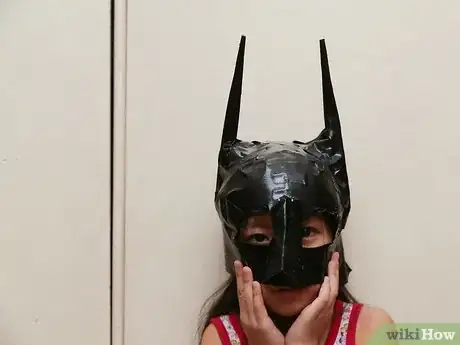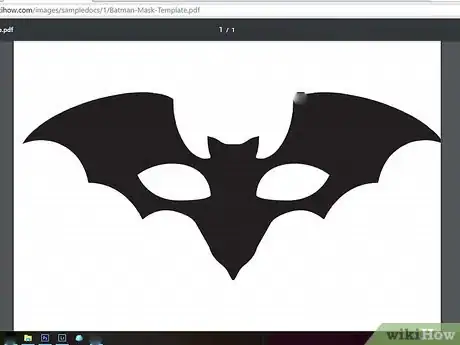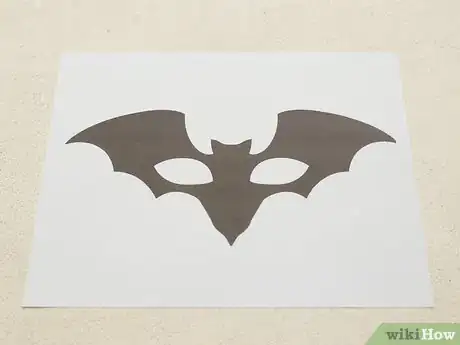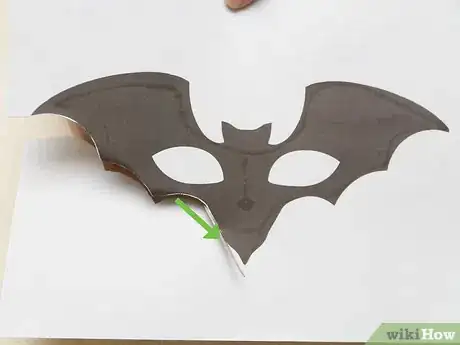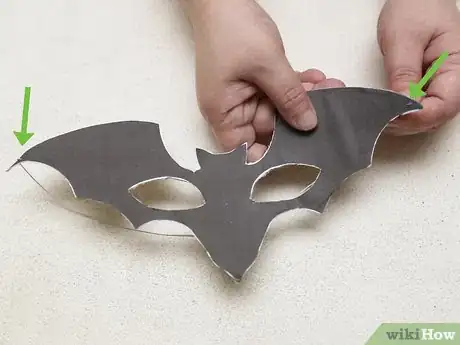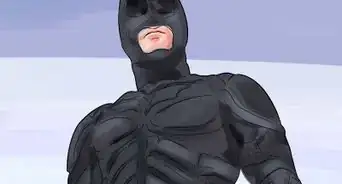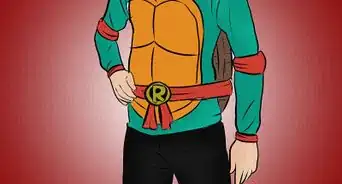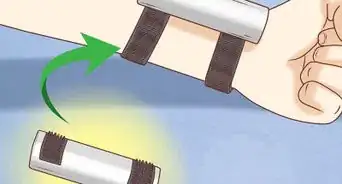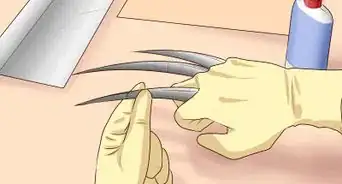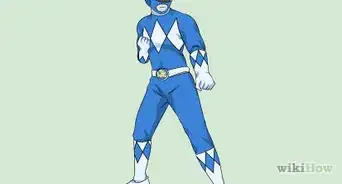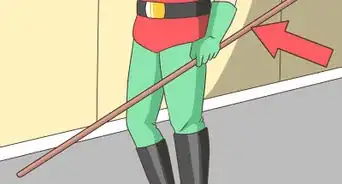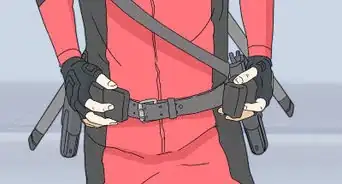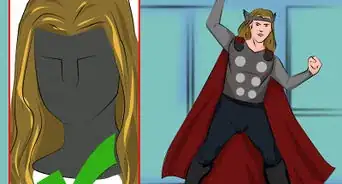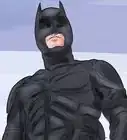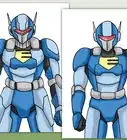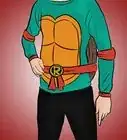This article was co-authored by wikiHow Staff. Our trained team of editors and researchers validate articles for accuracy and comprehensiveness. wikiHow's Content Management Team carefully monitors the work from our editorial staff to ensure that each article is backed by trusted research and meets our high quality standards.
This article has been viewed 166,973 times.
Learn more...
Batman is an undeniable icon and favorite to both kids and adults. If you're looking to masquerade as a superhero, creating a Batman mask is a great way to complete your look. Whether you're after a simple eye mask or a complete head covering mask, there is a Batman mask that's right for you. You can print a mask template, create a mask using craft foam, or a complete head covering with cardstock. For a custom fit you can create a molded mask out of duct tape.
Steps
Creating a Basic Foam Mask
-
1Measure your face. You will need to measure half the circumference of the wearer's head, the height of the wearer's face from the nose up, and the distance between the nose and the eyes. Record the measurements to create a custom template for your mask.
- Use a tape measure to measure the distance between the front of one ear to the front of the other, wrapping the tape measure around the front of the face.
- Measure the distance from the bottom of the nose to the top of the forehead.
- Measure the distance between the bottom of the nose and the bottom of the eyes, as well as the dimensions of the eyes themselves.
-
2Sketch the mask outline on plain paper. This can be a bit tricky, but armed with your measurements, you can create a shape custom-fit to the wearer's face.[1]
- Draw a horizontal line that matches the width of the wearer's face.
Advertisement -
3Draw the part of the mask that will cover the nose. Find the midpoint of the line and make a mark 1 inch below the line. Use a ruler to draw a line from the right-hand end of the line to this point. Draw a second line from the left-hand end of the line to this point.[2]
- Draw two downward-angled lines from the edges of the original line. The lines should meet together in a slight peak about 1 inch below the center of the original line.
-
4Sketch the outline of the ears and top of the mask. The ears will curve upward from the ends of the original horizontal line.
- Draw two curved vertical lines from the edge of the original line. These lines should equal the height measurement from the nose to the forehead taken earlier plus an additional 3 inches (7.6 cm).
- Draw another curved line on the end of each "side" line. The lines should come inward, forming curved triangles, and the base of each triangle should be about 2 inches (5 cm) wide. These triangles form the ears of the mask.
- Draw a line connecting the two top triangles across the top of the mask.
-
5Draw eye holes. Sketch out two almond-shape eyes holes.
- The position of the bottom of the eye holes should roughly match the distance between the wearer's nose and the bottom of the wearer's eyes.
- Measure from the center of the original horizontal line to the bottom edge of the inner portion of the eye.
- The eye holes themselves should be about twice the sides of the wearer's eyes.
- Angle the eyes slightly so the narrow part of the almond shape points inward and downward.
-
6Cut everything out. Use scissors to cut around the outline of the mask and the eye outlines.[3]
-
7Trace the shape onto black craft foam. Use pen to transfer the shape of the mask and eyes onto craft foam.
- While a black Batman mask is the most traditional choice, you can use any color you want if you plan on making these masks as favors for a children's party.
-
8Cut the mask out. Use scissors to carefully cut out the outline of the mask and the eyes from the foam.
-
9Punch two small holes along the side of the mask. Punch the holes into each side of the mask, near the edge and aligned with the center of the eye holes.
- A hole punch works well for this, but you could also use the tip of your scissors.
-
10Attach elastic thread to the holes. Tie one end of the elastic into one hole and the other end to the other hole. The elastic should be long enough to fit around the back of the wearer's head.[4]
- Double-knot the thread to hold it in place.
Making a Cardstock Head Covering Mask
-
1Cut a rectangular piece of black cardstock. You should be able to wrap the rectangle around your head without any skin or hair peeking through.[5]
- Use a tape measure to measure the diameter of your head. Add 1 inch (2.5 cm) to this measurement for the length of the rectangle.
- Measure the height of your head from the top to your chin. Add 5 inches (13 cm). This is the width of the rectangle.
- You could also use thin cardboard instead of cardstock.
- If you can't find black cardstock, brown or white will work. You will need to paint the mask when you're finished.
-
2Draw the top outline of the mask. You will need to draw the ears along with the upper edge of the mask.
- Measure the amount of space between your ears using a tape measure. Start at the front of one ear and wrap the tape measure around the front of your face until you reach the front of your other ear.
- Repeat the measuring process with the back of your head. Start at the back of one ear, wrap the tape measure around the back of your head, and bring it up to the back of your other ear.
- Divide the back measurement in half and add 1/2 inch (1.25 cm). On the left side of the cardstock, draw a horizontal line of this length 5 inches (13 cm) down from the top of the rectangle. Draw a matching line on the other side of the cardstock.
- In between the two lines, draw a third line that roughly matches the front measurement of your face. Leave 1 to 2 inches (2.5 to 5 cm) of empty space in between this line and the original two.
- Draw a vertical line at each end of this inner line. The line should extend up to the top of the cardstock.
- Draw a curved line from the top of these vertical lines down to the ends of your original horizontal lines.
-
3Draw a space for your mouth and chin. Create two "3" shapes at the bottom center of the mask. One "3" should face the correct way and the other should be backwards. The top points of the "3" shapes should connect, but the bottom should not.
- Measure the distance from the bottom of your nose to your chin. This is the height of your mouth hole.
- Measure the distance between the outside tip of one eye to the outside tip of the other. This is the width of the mouth hole.
-
4Finish the bottom outline. You will need to separate the mouthpiece from the rest of the bottom.
- Draw two curved lines upward beginning 1/2 inch from the bottom point of each "3" shape. The curved lines should be about 3 inches (7.6 cm) tall and extend about 2 inches (5 cm) away from the "3" shape at the widest part.
- This will form two fang like outlines on either side of the opening for the mouth.
- Draw a horizontal line at the upper end of each of these curved lines. The horizontal lines should extend to the side of the cardstock.
-
5Sketch out the eyes. The eyes are two slanted almond shapes and should be slightly larger than the shape of your actual eyes.
- The eyes must slant upward.
- Measure the distance between the bottom of your nose and the bottom of your eyes to get an idea of where to place the eye holes.
-
6Cut everything out. Cut along all of the lines to create your basic outline.
-
7Connect the two edges. Carefully curve the two ends in so that they meet at the back of the mask. Tape or glue them together.
- There can be between 1/2 inch and 1 inch (1.25 cm and 2.5 cm) of overlap between the two ends.
-
8Cut out a nose piece. The nose piece is made with a single diamond-shaped piece of cardstock.
- Measure the width and height of your nose. Add 1/4 inch (0.635 cm) to each measurement.
- Draw a diamond at the corner of a new piece of cardstock. The diamond should match the nose measurements taken previously.
- Cut the diamond out and bend it in half vertically.
-
9Attach the nose piece to the mask. Draw a diamond shape at the nose portion of your mask. It should be as long and wide as your nose.
- Cut this segment of the mask base out.
- Glue or tape the nose piece to this newly-cut edge.
-
10Create a top for the mask. Place a piece of cardstock over the top of your mask and trace a circle matching the same dimensions. Cut this circle out.
-
11Attach the top. Apply a layer of glue along the top edge of the mask. Gently press the top circle onto this line of glue and let dry.
Creating a Duct Tape Mask
-
1Cut a large oval from the side of a plastic grocery bag. Place the bag over the top of your head making sure it does not cover your eyes mouth or nose.[6]
- The plastic should cover your hair and sides of your head. The remaining excess can be trimmed away later.
- This plastic acts as a protective barrier against the duct tape.
-
2Cover the plastic bag in duct tape. Tear off 5-8 inch strips of duct tape and attache them to the bag. You will cover the entire bag creating a helmet made of duct tape. Be careful not to stick the duct tape to your skin or hair and only attach it to the plastic.
- You may find it easiest to begin at the top of your head and work your way around to the front, sides, and back.
- Tape across the plastic covering your forehead. The duct tape should come down to your eyebrows before smoothly transitioning down over your ears and around the back of your neck.
- For best results, use black duct tape. Doing so will be easier than attempting to color silver duct tape later.
-
3Make a nose covering. Fold a 4 inch strip of duct tape in half lengthwise. Tape the strip to the center of the forehead portion of your mask extending down between your eyes and over your nose.[7]
- Attach two more folded 6 inch strips of duct tape from the nose piece extending outward to your ears. This will create a "T" shape that goes between and under your eyes and covers your nose.
- Make sure that you do not cover your mouth.
- Leave spaces for eye holes.
- Apply more duct tape, as necessary, to create a snug fit around your cheeks and nose.
-
4Draw an outline for a nose. Look in the mirror with the mask base on. Draw a triangle around your nose, extending from the top of the bridge down to the bottom of your nostrils.
-
5Cut out and attach cardboard for the nose. You will need to cut out two triangular pieces of cardboard to build your nose piece. After cutting the pieces out, attach them to the mask along your nose outline using more duct tape.[8]
- You may find it easier to remove the mask temporarily for this part.
- Tape the cardboard triangles to the mask to create a pointed nose piece.
-
6Create the lower portion of the mask. Use more plastic bag material and duct tape to cover the rest of your cheeks. Cut two circles 4 inches in diameter to cover your cheeks.
- Tape additional plastic cut from another bag to the cross strip going under your eyes. Cover the plastic with duct tape to finish the cheeks of the mask.
- The entire mouth and chin area should still remain open.
-
7Create the ears. Each ear should be made from three triangular strips of cardstock, joined together to make a narrow prism shape. Stuff the prisms with newspaper, and tape them together with more duct tape.
- Attach the mask ears at the top of the mask so that they line up with your actual ears. Use more duct tape to attach the ears.
- As you wrap the ear shapes in duct tape, you should bend them slightly inward so that they have a slightly more rounded and less rigid appearance.
- There are no exact measurements for the ears, but in general, they should be fairly tall and narrow. As an estimate, make the base about 2 inches (5 cm) wide. The length should be about 6 inches (15.25 cm).
-
8Sculpt and trim the mask. Remove the mask from your head. Use additional layers of plastic bag material and duct tape to define the eye holes, nose, and lower edge.
- Fill the mask with wadded grocery bags to prevent the mask from caving in as you work.
- The mask eyes should be a defined "almond" shape. The holes should be about twice as large as the shape of your eyes.
- Use tape to create a smooth edge along the nose and the rest of the lower edge of the mask. Trim away any visible plastic.
- If desired, you could also cover the mask with another layer of tape to hide any uneven, criss-crossing tape lines and provide the mask with more support and structure.
-
9Try the mask on one last time. It should be complete at this point.
- If you are still unsatisfied with the shape or look of the mask, continue sculpting it while looking at yourself wearing the mask in the mirror.
Printing a Mask Template
-
1Download the mask template. Save the picture file to your hard drive to access the file on your computer.
-
2Load cardstock into your printer. Use a heavy weight paper to print your mask to make it more durable.
- Configure your printer's settings for a heavy duty paper to ensure that the paper feeds through the printer correctly.
-
3Print the template file. Select the document for the mask template and open it using your computer's PDF reader or MS-Word.
-
4Cut out the mask. Cut around the edge of the mask template with scissors to cut out the mask. Poke scissors into the eye holes to cut out the eyes in the middle of the mask.
-
5Attach a string to the mask. Use a hole punch to create a hole on each side of the mask. Tie a string to each end of the mask.
- Tie one end of the string and hold the mask up to your face. Wrap the string around the back of your head to measure how long to make the string before tying it to the other side of the mask.
- Reinforce the holes and attached string with a piece of tape to avoid tearing the mask when you wear it.
Community Q&A
-
QuestionCan I make one out of molded clay?
 Community AnswerYes, you can make one out of molded clay.
Community AnswerYes, you can make one out of molded clay. -
QuestionCan I paint the mask?
 Community AnswerIt depends on what material you use to make the mask. Make sure to wait a long time after painting before wearing it so you don't breathe any paint fumes.
Community AnswerIt depends on what material you use to make the mask. Make sure to wait a long time after painting before wearing it so you don't breathe any paint fumes.
Things You'll Need
Basic Foam Mask
- Paper
- Pencil
- Pen
- Scissors
- Black craft foam
- Elastic thread
- Hole punch
- Tape measure
3D Cardstock Mask
- Cardstock
- Tape
- Glue
- Scissors
- Tape measure
- Marker, pencil, or pen
- Black paint
Duct Tape Mask
- Plastic grocery bag material
- Black duct tape
- Cardboard
- Cardstock
- Scissors
- Permanent marker
- Mirror
Mask Template Cutout
- Cardstock
- Printer
- Scissors
- String
References
- ↑ https://www.youtube.com/watch?v=bDmFS542Dbk
- ↑ https://www.youtube.com/watch?v=D6h5PcvK2So
- ↑ https://www.youtube.com/watch?v=D6h5PcvK2So
- ↑ https://www.youtube.com/watch?v=bDmFS542Dbk
- ↑ http://www.youtube.com/watch?v=O-5AA3tf4KA
- ↑ http://blog.makezine.com/2008/10/27/duct-tape-batman-mask/
- ↑ https://www.handmadecharlotte.com/diy-lego-batman-mask/
- ↑ https://www.handmadecharlotte.com/diy-lego-batman-mask/
About This Article
To make a Batman mask, start by measuring half the circumference of the person’s head, the height of the face from the nose up, and the distance between the nose and eyes. Next, use these measurements to sketch the mask outline on plain paper, and draw the nose, ears, top of the mask, and eye holes. Then, cut out your outline, trace the shape onto black craft foam, and cut out your mask. Finally, punch 2 small holes on each side of the mask and attach elastic thread to the holes. For more tips, like how to create a Batman head covering mask, read on!
